The rate of inflation is down sharply and it is expected to slow further in 2024, after reaching its highest level in 40 years in 2022.
But even that rosy macro view will continue to be felt unevenly throughout the economy in 2024.
About 52% of Texans said they were highly stressed about inflation, compared with 47% of U.S. residents overall, according to U.S. Census data released in November. The higher stress was attributed to Texas having a larger share of its population living below the poverty level than the national rate.
The Federal Reserve has lowered its expectations on inflation which means at least the cost of borrowing money will plateau. Morningstar economists have an optimistic view for inflation to average 1.8% from 2024 to 2027, below the Fed’s inflation target of 2%.
Inflation is blamed most frequently by consumers who say the economy isn’t on the right track, even though wages are up and the unemployment rate is low.
“Consumer and business surveys show that people care more about the level of prices — very high! — than the CPI’s rate of increase,” said Bill Adams, chief economist for Comerica Bank, in an email.
The 3.1% increase in November’s U.S. consumer price index was only about a percentage point above the pre-pandemic November, Adams said. “The share of small businesses who say that inflation is still their single largest problem is down from its 2022 peak but still above any time between 1982 and 2020.”
Dallas-Fort Worth inflation is expected to remain above the U.S. rate largely because of the cost of renting and owning a home. D-FW’s inflation rate of 5.2% in November would have been about 3.1%, or the same as the U.S. rate if housing costs were lower, said Julie Percival, Southwest regional economist for the bureau.
Supply chain corrections have helped lower prices for consumer goods such as furniture, toys, electronics and apparel. Food prices for dairy, eggs, chicken and seafood have dropped. Still, too many grocery items are well above pre-pandemic prices.
For individual households, the reality of higher prices comes in waves — a lease renewal on an apartment, an airline ticket, the annual homeowner’s insurance bill and the less frequent need to replace the car.
More of that will be felt in 2024.
Bought a car lately?
With the average age of a car on the road today at 12.5 years, more people are about to experience sticker shock — a term that first came on the scene when Americans went car shopping in the early 1980s.
The inflation rate was 14.5% in 1980 and new safety and energy-saving features pushed car prices higher.
Sticker shock is back for anyone who hasn’t purchased a car in at least a decade. Ten years ago the average vehicle cost $31,356, according to Kelley Blue Book. The average new car price was $48,247 in November, and that was down 1.5% from a year ago, but still 23% higher than three years ago.
Car dealers are offering low promotional interest financing rates to ease the pain on select models. Inventory levels have moved to the consumers’ advantage. New vehicle inventory on dealers’ lots and in transit, surpassed 2.5 million units in early December for the first time in two years, according to Cox Automotive. That’s up 57%, or 925,000 units, from a year ago and represents a 71-day supply.
Still, car buyers may have to remain flexible to find a low-priced car, according to Cox Automotive. For Toyota, Honda and Kia, shoppers need to hunt harder and pay more for hard-to-find models, which the research firm said include the new Toyota Grand Highlander, Honda CR-V and its hybrid version, Toyota Camry, Corolla and RAV4 and the Honda Civic.
Food prices ease
While car purchases are infrequent, visits to the grocery store are constant reminders that prices are high. But at least food prices are trending lower.
Egg inflation should remain an early 2023 headline.
Prices on the key staple eased in 2023 with a dozen Grade A eggs priced at just under $2 in the Dallas area at Walmart, H-E-B and Kroger.
The largest U.S. grocer is talking about deflation next year.
“We may be managing through a period of deflation in the months to come,” said Walmart CEO Doug McMillon last month during a conference call to review earnings. “And while that would put more unit pressure on us, we welcome it, because it’s better for our customers.”
Some of the last grocery prices to come down are in the middle of the store, the dry groceries such as breakfast cereals.
Will those categories come down? “We hope they will,” McMillon said.
On a two-year stack, Walmart’s dry grocery prices are still up in the “mid-double digit” percent increase range, or up in the 14% to 16%.
It may take some arm-twisting from Walmart to get breakfast cereal prices down.
“We’ve seen the inflationary environment stabilize at the current levels,” said Dave McKinstray, chief financial officer of WK Kellogg Co. during a call with investors last month.



